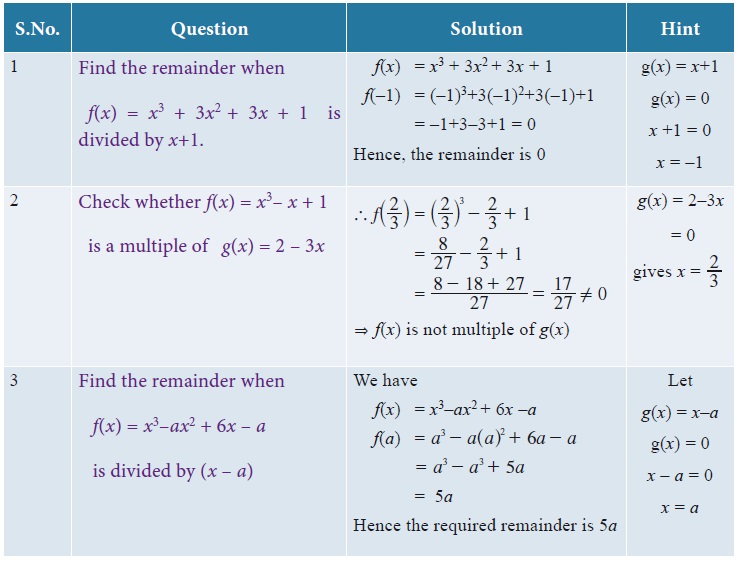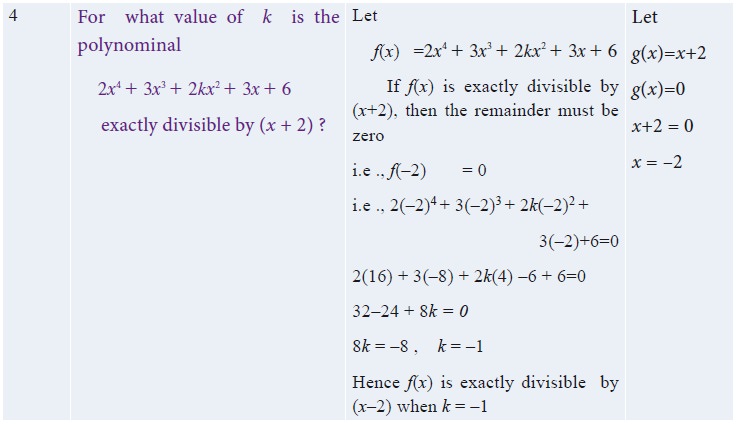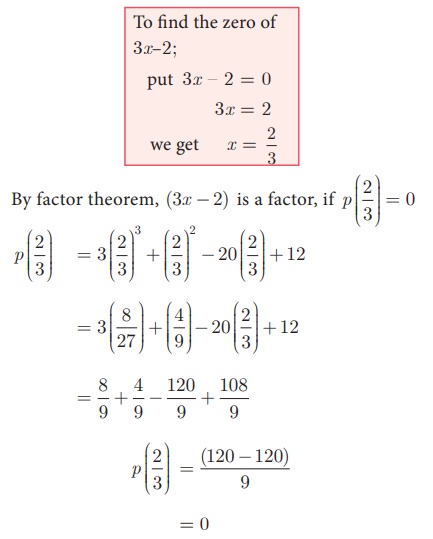Explanation, Example Solved Problems | Algebra | Maths - Remainder Theorem | 9th Maths : UNIT 3 : Algebra
Chapter: 9th Maths : UNIT 3 : Algebra
Remainder Theorem
Remainder Theorem
In the previous section , we have learnt the division of a polynomial by another non – zero polynomial.
In this section , we shall study a simple and an elegant method of finding the remainder.
In the case of divisibility of a polynomial by a linear polynomial we use a well known theorem called Remainder Theorem.
If a polynomial p(x) of degree greater than or equal to one is divided by a linear polynomial (x–a) then the remainder is p(a), where a is any real number.
Significance of Remainder theorem : It enables us to find the remainder without actually following the cumbersome process of long division.
It leads to another well known theorem called ‘Factor theorem’.

Example: 3.15


Example 3.16
If the polynomials f(x) = ax3 + 4x 2 + 3x –4 and g(x) = x3– 4x + a leave the same remainder when divided by x–3, find the value of a. Also find the remainder.
Solution
Let f(x) = ax3 + 4x 2 + 3x –4 and g(x) = x3– 4x + a, When f(x) is divided by (x–3), the remainder is f(3).
Now f(x) = a(3)3 + 4(3) 2 + 3(3) –4
= 27a + 36 + 9 – 4
f(3) = 27a + 41 (1)
When g(x) is divided by (x–3), the remainder is g(3).
Now g(3) = 33 – 4(3) + a
= 27 – 12+ a
= 15 + a (2)
Since the remainders are same, (1) = (2)
Given that, f(3) = g(3)
That is 27a + 41 = 15 + a
27a – a = 15 – 41
26a = –26
a = - 26/26 = –1
Substituting a = –1,in f(3), we get
f(3) = 27( ) - + 1 14
= – 27 + 41
f(3) = 14
so The remainder is 14.
Example 3.17 or 3.12
Without actual division , prove that f(x) = 2 x4 - 6 x3 + 3 x2 + 3x - 2 is exactly divisible by x2 –3x + 2
Solution :
Let f(x) = 2 x4 - 6 x3 + 3 x2 + 3x - 2
g(x) = x2 –3x + 2
= x2-2x-x+2
=x(x-2)-1(x-2)
=(x-2)(x-1)
we show that f(x) is exactly divisible by (x–1) and (x–2) using remainder theorem
f(1)= 2 (1)4 - 6 (1)3 + 3 (1)2 + 3(1) - 2
f(1)=2-6+3+3-2=0
f(2)= 2 (2)4 - 6 (2)3 + 3 (2)2 + 3(2) - 2
f(2)=32-48+12+6=0
f(x) is exactly divisible by (x – 1) (x – 2)
i.e., f(x) is exactly divisible by x2 –3x + 2
If
p(x) is divided by (x -a) with the remainder p(a ) =
0 , then (x -a) is a factor of p(x). Remainder Theorem leads
to Factor Theorem.
1. Factor Theorem
If p(x)
is a polynomial of degree n ≥ 1 and ‘a’ is any real number
then
(i) p(a
) = 0 implies (x -a) is a factor of p(x).
(ii) (x
-a) is a factor of p(x) implies
p(a ) = 0 .
Proof
If p(x)
is the dividend and (x -a) is a divisor, then by division algorithm we write, p(x)
=
(x −a)q (x) + p(a) where q (x)
is the quotient and p(a) is the remainder.
(i)
If p(a) = 0, we get p(x) =
(x −a)q (x) which shows that (x -a) is a factor of p(x).
(ii)
Since (x -a) is a factor of p(x) , p(x) =
(x – a)g (x) for some polynomial
g (x) .
In
this case
p(a ) =
(a −a)g (a )
= 0
×g (a )
=
0
Hence,
p(a) = 0, when (x -a) is a factor of p(x).
Thinking Corner
For any two integers a(a ≠ 0) and b, a divides b if b =
ax, for some integer x.
Note
• (x -a) is a factor of p(x) , if p(a) = 0 ( x–a
= 0, x = a)
• (x + a) is a factor of
p(x)
, if p(–a) = 0 ( x+a = 0, x = –a)
• (ax+b) is a factor of p(x) , if p(–b/a)
= 0 ( ax + b = 0, ax = −b, x = − b/a)
• (ax–b) is a factor of
p(x) , if p(b/a) = 0 { (ax
– b) = 0, ax = b, x = b/a
)
• (x–a) (x–b) is a factor of p(x) , if p(a)=0
and p(b) = 0 ( x − a = 0 or x − b = 0 , x = a or x = b )
Example 3.13
Show
that (x + 2) is a factor of x 3
−
4x2 −2x +
20
Solution
Let
p(x) = x 3 − 4x2 −
2x +
20
To find the zero of x+2;
put x + 2 = 0
we get x = –2
By
factor theorem, (x + 2) is factor of p(x), if p(− 2) = 0
p(−
2) = (− 2)3 − 4(− 2)2 −2(− 2) + 20
= −8−4(4)+4+20
p(− 2) = 0
Therefore,
(x + 2) is a factor of x3 −
4x2 −2x +
20
Example 3.14
Is
(3x -2) a factor of 3x3 +
x2 −20x +12
?
Solution
Let
p(x) = 3x3 + x2 −20x +12

Therefore,(3x
-2)
is a factor of
3x
3 + x2 −20x +12
Progress Check
1. (x+3) is a factor of p(x),
if p(__) = 0
2. (3–x) is a factor of p(x), if
p(__) = 0
3. (y–3) is a factor of p(y),
if p(__) = 0
4. (–x–b) is a factor of p(x),
if p(__) = 0
5. (–x+b) is a factor of p(x),
if p(__) = 0
Example 3.15
Find the
value of m, if (x -2) is a factor of the polynomial 2x3
−
6x2 +mx + 4 .
Solution
Let
p(x) = 2x3 −6x2
+
mx + 4
To find the zero of x–2;
put x – 2 = 0
we get x = 2
By
factor theorem, (x -2) is a factor of p(x)
, if p(2) = 0
p(2) = 0
2(2)3
−
6(2)2 +m(2) + 4 = 0
2(8)
−
6(4) +
2m + 4 = 0
− 4 + 2m =
0
m = 2
Related Topics